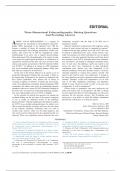EDITORIAL
T h r e e - D i m e n s i o n a l E c h o c a r d i o g r a p h y : R a i s i n g Qu e s t i o n s
And Providing Answers
A ORTIC VALVE REPLACEMENT is a category II
indication for intraoperative transesophageal echocardio-
graphy (TEE). Increasingly in the operating room, TEE has
comfortably navigated with the help of 3D TEE and its
quantitative analysis.
Subaortic membranes usually present with symptoms similar
become a modality of choice for assessing valves, planning to those of aortic stenosis and may be congenital or acquired.7
surgical intervention, and evaluating postoperative valvular com- Combined with the high gradients across the LVOT, they may
petence. This central role of TEE has catapulted the cardiac be difficult to differentiate from aortic valvular stenosis, espe-
anesthesiologist to an active role in surgical decision-making. cially if presenting in an elderly individual. In case of acquired
Three-dimensional (3D) echocardiography in the context of aortic membranes, it has been postulated that they result from altered
valve surgery has gained special prominence, as evidenced by its flow dynamics in the LVOT, generating shear stress, inflamma-
superiority in assessment of the aortic valve area, severity of aortic tion, and fibrosis, and leading to subsequent membrane forma-
stenosis, and anatomy and geometry of the left ventricular outflow tion.7 In such cases, the pathology usually may extend to and
tract (LVOT).1,2 In addition to its routine use, TEE examination involve the aortic valve. Alternatively, in older individuals,
may reveal incidental and/or unexpected findings, telling more concomitant aortic stenosis may exist independent of the
than what was expected to be discovered.3–5 subaortic membrane. Given these possible scenarios, it becomes
In this issue of the Journal, Mancuso et al6 present a case of especially important to evaluate these patients critically with
unexpected intraoperative findings that necessitated a debate on regard to their need for aortic valve replacement. A misstep in
the surgical plan. Preoperatively, the patient was diagnosed with the wrong direction can lead to significant, undue morbidity and
have critical symptomatic aortic stenosis due to history of mortality. Therefore, careful and comprehensive use of tools
worsening symptoms of shortness of breath and near-syncope. such as 3D TEE, multiplanar reformatting, and planimetry
Aortic valve replacement was planned. During intraoperative TEE should be made whenever possible in order to aid and assist
examination, the authors came across an unanticipated subaortic in diagnostics as well as management.8,9
membrane, which was a source of LVOT obstruction. Findings on Clinical usage of quantitative data truly underscores the
the aortic valve were equivocal, with partial thickening, regurgita- utility and clinical value of intraoperative 3D TEE. It already
tion, and a high gradient across her LVOT on Doppler. has been appreciated that 3D echocardiography not only raises
In this situation, the logical next question was whether the questions but also provides answers. This E-challenge case
incidental finding was the real cause of the patient's symptoms report goes a step further in which this additive information
or was it simply an additional feature of the pathology provided the central piece to solving the puzzle.
diagnosed earlier? Utilizing multiplanar reformatting to analyze
the LVOT across multiple orthogonal planes, the authors were Khurram Owais, MD
able to ensure the absence of artifacts and assess the true extent Mario Montealegre-Gallegos, MD
of the subaortic membrane. Planimetry then was used to Feroze Mahmood, MD
exclude aortic stenosis, which was the initial diagnosis, and Department of Anesthesia, Critical Care, and Pain Medicine
rule out the need for replacement for the regurgitation that was Beth Israel Deaconess Medical Center, Harvard Medical
observed. These were significant clinical decisions that were School, Boston, MA
REFERENCES
1. Saitoh T, Shiota M, Izumo M, et al: Comparison of left ventricular 5. Demirkol S, Balta S, Arslan Z, et al: Absent left main trunk in a
outflow geometry and aortic valve area in patients with aortic stenosis patient with subaortic membrane detected by three-dimensional echo-
by 2-dimensional versus 3-dimensional echocardiography. Am J cardiography. Eur Heart J Cardiovasc Imaging 14:37, 2013
Cardiol 109:1626-1631, 2012 6. Mancuso AJ, Clark J, Mahmood F. Left ventricular outflow tract
2. Jainandunsing JS, Mahmood F, Matyal R, et al: Impact of three- obstruction: is it the valve or something else. J Cardiothorac Vasc
dimensional echocardiography on classification of the severity of aortic Anesth 2014.
stenosis. Ann Thorac Surg 96:1343-1348, 2013 7. Ezon DS: Fixed subaortic stenosis: A clinical dilemma for
3. Shahian DM, Labib SB, Chang G: Cardiac papillary fibroelas- clinicians and patients. Congenit Heart Dis 8:450456, 2013
toma. Ann Thorac Surg 59:538-541, 1995
4. Giannoccaro PJ, Sochowski RA, Morton BC, et al: Complemen-
tary role of transoesophageal echocardiography to coronary
angiography in the assessment of coronary artery anomalies. 70:70- © 2014 Elsevier Inc. All rights reserved.
74, 1993 1053-0770/2602-0034$36.00/0
http://dx.doi.org/10.1053/j.jvca.2014.02.014
Journal of Cardiothoracic and Vascular Anesthesia, Vol ], No ] (Month), 2014: pp ]]]–]]] 1




